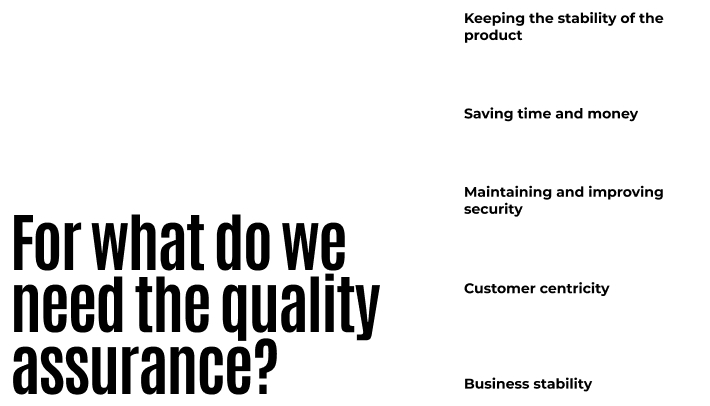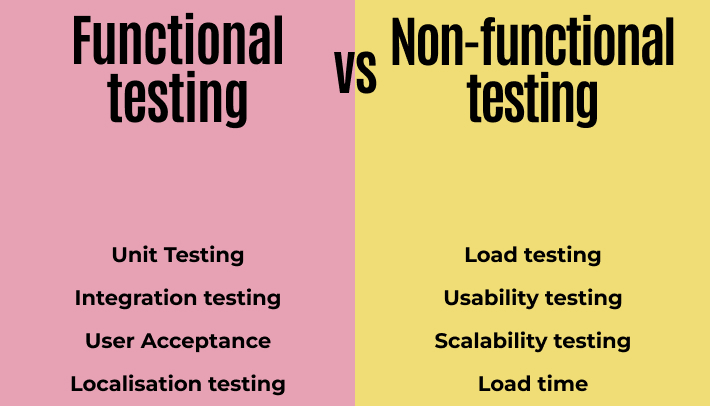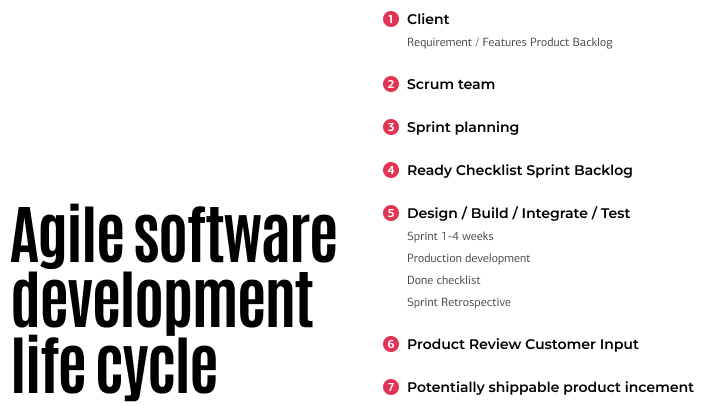People hear about quality all-around all day long. Similarly, the development process and software products have their own “quality” marks.
In one of the previous articles, we have already discovered the main steps in the development life cycle for most of the products. Now comes the time to define the step that takes the second place in the definition of the effectivity of the product. Its name is testing or Quality Assurance.
We are going to describe the overall process of quality assurance, its main stages, purposes and tools used. Find if quality assurance serves the defining role in the building of a great product, or its role is overestimated in the reality.
What is quality assurance?
The general definition sounds like that: quality assurance is the scope of actions taken to maintain the sufficient level of the serviceability of the product. As well as the product’s ability to deliver the intended value. Though quality assurance is the separate (pre-final) stage of the software development, it has sub-steps in every other stage of the development. To be really effective, it starts with planning and never stops even after the deployment.
For what do we need the quality assurance?
Though the definition shows that the quality area is broad and complicated, its core functions are rather clear – to make the digital product serve properly. But trying to dive deeper, we can find that the true quality can make much more for the sake of the business.
The quality assurance, besides the most obvious functions, serves the following:
- Keeping the stability of the product.
Testing can ensure not only the initialisation and launch of the product to the market but also create the stable ground for future scalability and development. Similarly, continuous maintaining of the stable operation shows the users that the product is vivid and reliable.
- Saving time and money.
When making the high-quality product from the start, the business saves time and funds on introducing the rectifications in future. That is one of the reasons why quality assurance should be introduced in the course of the entire development, starting from planning. Even generally revealing the failures or bugs is better than allowing them to stay in the product and increase the churn rate.
- Maintaining and improving security.
The level of security, in large part private data security, is one of the core points of modern software. Quality assurance has the separate block of various tests that are performed to uncover vulnerabilities and threats. They include penetration tests, vulnerability scanning, risk assessment.
- Customer centricity.
A combination of the stated above features makes the entire product serve the users in the first place. Such an approach enhances the user experience that in some cases becomes the defining factor whether the product will find success. Caring about the satisfaction of the customers ensures the future stability of the traffic and makes the reputation of the service provider grow.
- Business stability.
Even when making the product not for the users but for yourself, testing it thoroughly according to work plan can save the business from occasional emergencies. An unexpected bug can bring mess and frustration to the internal processes and sometimes threaten the business. System blackouts, failures of databases, missed communication are only the smallest things to happen.

These functions are called not only for ensuring the basic launch of the product but also its future development. In terms of customer care, a quality-based approach can enlarge the audience and increase the reliability of the existing users.
Types of quality assurance tests
Functional and non-functional testing
The QA professionals work in teams and participate in most stages of the development lifecycle. They join the process to define the parameters of whether the product satisfies the primary goals stated by the business.
Based on this point, it is possible to separate two types of testing procedures: functional and non-functional testing. The functional testing deals with the outer part of the product – what the product does; non-functional is about the inner kitchen – how it does what is needed.

Functional tests are needed to check if the initial requirements are satisfied with the product’s functions. They are built on the assumptions and analysis of the business and can change after the product receives real users.
Non-functional tests verify the performance and build the ground for future scalability or improvements. These tests show a more general approach to the product.
Manual and automated testing
Another segregation is about manual and automated testing of the product. The discrepancies are rather obvious – the first one is done by testers alone, the second one – with the code. Each of these approaches has its weak and strong points and should be applied based on the specific aim that should be satisfied.
Manual testing
Pros
- requires fewer skills from a tester;
- can be started at once;
- shows human insight.
Cons
- can be rather subjective and depends on the tester skills;
- requires more time and the physical presence of the tester.
Automated testing
Pros
- can be performed on a 247 basis;
- great scope of the functions can be checked at a time.
Cons
- needs the knowledge of coding from a tester;
- can’t replace the person in terms of UX;
- requires more time to be started.
Based on the stated above features, they are both necessary to cover all aspects of the product and complete its lifecycle. To perform the repetitive testing of the code, it is better to introduce automated testing, but in cases when it is needed to add the human touch or check if the product is intuitive and logical – apply human tests.
Thus, a combination of manual and automated testing is often used on real projects, the level of automation depends on the type of project as well as on the specifics of setting up production processes in a company.
Each testing type has its own techniques to provide the best solution to the initiated task. Manual testing deals with the Black box technique (when the tester does not interact with the code) and White box (when the tester interacts with the code, requests). Automated testing includes UI testing, E2E testing, integration testing, unit testing and others.
When it is necessary to perform each of these tests in the development life cycle?
Unit tests are the most common tests that take place in the entire process of development. They check the smallest parts of the code – units. Each unit is checked separately without the connection to the others and the overall serviceability of the system.
Integration testing confirms that all units combined to the groups work together properly. They check for possible weak points, uncommon information flows and possible inconsistency of modules.
E2E testing is necessary for projects with a high level of complexity; it includes both visual component testing and functional testing. In E2E, the entire application is downloaded as a whole and gets imitation of user actions.

Usability testing, high-load testing, security testing can be performed separately with more emphasis on their tested area or within the course of the bigger test bundle. Try selecting each methodology and testing type to suit the needs of the particular product and business goals.
The process of quality assurance implementation
The overall process to stay mature should cover the broad percentage of the product.
It starts with an analysis of the requirements, documentation conclusion, reporting standards definition. The accuracy of this preliminary stage greatly depends on the education of the testers and understanding of the strategy of the quality assurance process. Lack of such a strategic grasp will lead to a growing amount of bugs in future and low productivity.
The second block of testing implementation – the basic testing performing – requires education and continuous knowledge renewal. And that is not only about the techniques – the number of tools constantly grows as well. We can name some of the most common tools: Selenium, Appium, Jmeter, Postman, TestRail, Protractor, Cucumber, Charles Proxy, BrowserStack, Allure, Docker, AWS, Azure. One person should not perfectly know each of them, though the application of the particular tool should depend on the complexity of the project and its requirements.
And the final testing – continuous after launch testing – is more about enhancing the system. Nevertheless, it requires the high skills of the team as well.

Do quality assurance is A Must?
To build a really valuable product, various tests should be implemented in the entire process of the development right from its start. Cutting the budget on testing can bring higher expenses in future and threaten the entire serviceability of the product due to the lost devotion of the users. Correct implementation and application of proper techniques can help to avoid the risks and plan the mitigations (if some of them can not be totally avoided).
When building a great and effective custom solution, a business should consider the value of a high-quality product. If you are ready to feel the thorough approach of our team to testing – contact us, and we gladly show you the plan with all steps and testing techniques included.


















